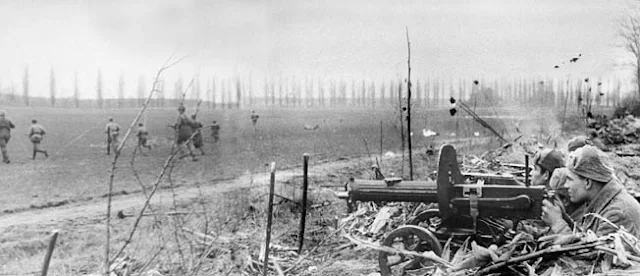 |
| A Japanese aerial view of the Pearl Harbor attack. |
 |
| A World War II Japanese-centric map of Hawaii. |
 |
| Admiral Isoroku Yamamoto. |
 |
| The fate of the USS Arizona (BB-36). |
 |
| The Last Moments of Admiral Yamaguchi, Japanese war art by Kita Renzo. |
 |
| A German Panther in winter camouflage rumbles through a village during Operation Konrad in January 1945. |
 |
| Soviet troops slain in combat lay in a snow-covered ditch in Hungary. |
 |
| Soviet machine gun teams in action in Hungary. |
 |
| Generalleutnant Willi Bittrich. |
 |
| Marshal Fyodor Tolbukhin. |
 |
| SS Panzer Grenadiers and police units fought side-by-side in Hungary during the spring offensive. |
 |
| Soviet self-propelled guns helped stem the German advance in Hungary. |
 |
| At the airport in Frankfurt, Germany, in 1940, a flight crew poses for a photographer with its Dornier Do 17 reconnaissance aircraft. |
 | |
| Helmut Rau, seated in the observer position aboard a Heinkel He 111 reconnaissance plane, takes weather readings. |
 |
| Heinkel He 111 on an airfield in Norway. |
 |
| GIs move up an old hillside trail in Italy, accompanied by a pack mule. |
 |
| Childers served in the Army through Korea and the start of the Vietnam War, and reached the rank of lieutenant colonel before retiring from the Army in 1965. |
 |
| American GIs move through the streets of a shelled Italian town. |
 |
| Japanese Mitsubishi G4M2 Betty bombers wing their way toward a target. |
 |
| A Heinkel He 111Z 'Zwilling' (twin) lifts off from the airfield in Hildeshein, Germany, with two Gotha Go 242 gliders in tow. Date unknown. |
 |
| Illustration representing World War II ships built under the Bethlehem Steel program across various shipyards, totaling 1,121 ships. |
 |
| Admiral Chester W. Nimitz in the doorway of a bunker on Midway Island while on an inspection trip after the Battle of Midway, June 1942. |
 |
| With one man carrying a small motor scooter on his shoulder, men of 48 Commando disembark from landing craft at Juno Beach near St.-Aubin-sur-Mer, June 6, 1944. |
 |
| Making the initial landing at Nan Red Beach, on the left flank of Juno Beach, Canadian infantry disembark from their landing craft under German fire shortly after 8 am on D-Day. |
 |
| Making the initial landing at Nan Red Beach, on the left flank of Juno Beach, Canadian infantry disembark from their landing craft under German fire shortly after 8 am on D-Day. |
 |
| Men from 48 Commando and Canadian infantry with their bicycles take cover from German mortar fire in ditches near St.-Aubin-sur-Mer. |
 |
| Canadian infantrymen from the North Shore (New Brunswick) Regiment cautiously approach another German strongpoint, WN 27, at St.-Aubin-sur-Mer. |
 |
| Colonel Chesty Puller (second from left) visits men of the 7th Marines in camp at Cape Gloucester. |
 | |
| An ever-present figure near the front line, Chesty Puller (left) discusses troop dispositions with another officer. |
 |
| The five Sullivan Brothers, all of whom were lost in the sinking of the U.S.S. Juneau, November 13, 1942. |
 |
| Calutron Operators in Oak Ridge, Tennessee During World War II. |
 |
| Hiroshima after atomic bombing, March 1946. (National Archives Identifier 148728174) |
 |
| Dr. J. Robert Oppenheimer, atomic physicist and head of the Manhattan Project, ca. 1944. (National Archives Identifier 558579) |
 |
| Topographical map, Hiroshima. (National Archives Identifier 166126365) |
 |
| Col. Paul W. Tibbets, Jr., pilot of the Enola Gay, waves from the cockpit before takeoff, August 6, 1945. (National Archives Identifier 535737) |
 |
| Enola Gay returns after strike at Hiroshima, 1945. (National Archives Identifier 76048622) |
 |
| President Truman announces Japan’s surrender, August 14, 1945. (National Archives Identifier 520054) |
 |
| 6888th at the Snack Bar in Rouen, France. (Local Identifier: 111-SC-209179; National Archives Identifier: 175539159) |














